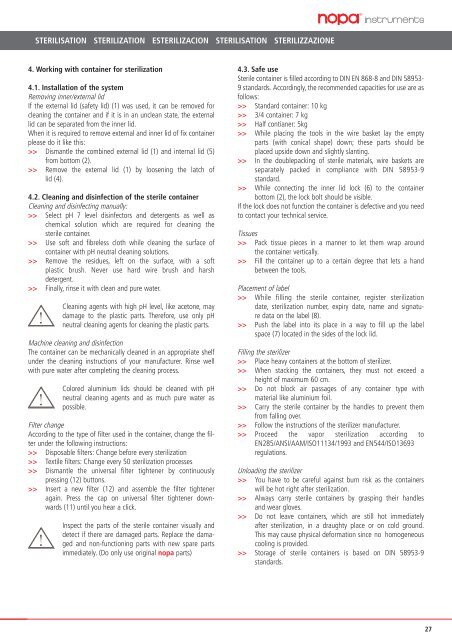Download - nopa instruments
Download - nopa instruments
Download - nopa instruments
Erfolgreiche ePaper selbst erstellen
Machen Sie aus Ihren PDF Publikationen ein blätterbares Flipbook mit unserer einzigartigen Google optimierten e-Paper Software.
STERILISATION STERILIZATION ESTERILIZACION STERILISATION STERILIZZAZIONE<br />
4. Working with container for sterilization<br />
4.1. Installation of the system<br />
Removing inner/external lid<br />
If the external lid (safety lid) (1) was used, it can be removed for<br />
cleaning the container and if it is in an unclean state, the external<br />
lid can be separated from the inner lid.<br />
When it is required to remove external and inner lid of fix container<br />
please do it like this:<br />
>> Dismantle the combined external lid (1) and internal lid (5)<br />
from bottom (2).<br />
>> Remove the external lid (1) by loosening the latch of<br />
lid (4).<br />
4.2. Cleaning and disinfection of the sterile container<br />
Cleaning and disinfecting manually:<br />
>> Select pH 7 level disinfectors and detergents as well as<br />
chemical solution which are required for cleaning the<br />
sterile container.<br />
>> Use soft and fibreless cloth while cleaning the surface of<br />
container with pH neutral cleaning solutions.<br />
>> Remove the residues, left on the surface, with a soft<br />
plastic brush. Never use hard wire brush and harsh<br />
detergent.<br />
>> Finally, rinse it with clean and pure water.<br />
Cleaning agents with high pH level, like acetone, may<br />
damage to the plastic parts. Therefore, use only pH<br />
neutral cleaning agents for cleaning the plastic parts.<br />
Machine cleaning and disinfection<br />
The container can be mechanically cleaned in an appropriate shelf<br />
under the cleaning instructions of your manufacturer. Rinse well<br />
with pure water after completing the cleaning process.<br />
Colored aluminium lids should be cleaned with pH<br />
neutral cleaning agents and as much pure water as<br />
possible.<br />
Filter change<br />
According to the type of filter used in the container, change the filter<br />
under the following instructions:<br />
>> Disposable filters: Change before every sterilization<br />
>> Textile filters: Change every 50 sterilization processes<br />
>> Dismantle the universal filter tightener by continuously<br />
pressing (12) buttons.<br />
>> Insert a new filter (12) and assemble the filter tightener<br />
again. Press the cap on universal filter tightener downwards<br />
(11) until you hear a click.<br />
Inspect the parts of the sterile container visually and<br />
detect if there are damaged parts. Replace the damaged<br />
and non-functioning parts with new spare parts<br />
immediately. (Do only use original <strong>nopa</strong> parts)<br />
4.3. Safe use<br />
Sterile container is filled according to DIN EN 868-8 and DIN 58953-<br />
9 standards. Accordingly, the recommended capacities for use are as<br />
follows:<br />
>> Standard container: 10 kg<br />
>> 3/4 container: 7 kg<br />
>> Half contianer: 5kg<br />
>> While placing the tools in the wire basket lay the empty<br />
parts (with conical shape) down; these parts should be<br />
placed upside down and slightly slanting.<br />
>> In the doublepacking of sterile materials, wire baskets are<br />
separately packed in compliance with DIN 58953-9<br />
standard.<br />
>> While connecting the inner lid lock (6) to the container<br />
bottom (2), the lock bolt should be visible.<br />
If the lock does not function the container is defective and you need<br />
to contact your technical service.<br />
Tissues<br />
>> Pack tissue pieces in a manner to let them wrap around<br />
the container vertically.<br />
>> Fill the container up to a certain degree that lets a hand<br />
between the tools.<br />
Placement of label<br />
>> While filling the sterile container, register sterilization<br />
date, sterilization number, expiry date, name and signature<br />
data on the label (8).<br />
>> Push the label into its place in a way to fill up the label<br />
space (7) located in the sides of the lock lid.<br />
Filling the sterilizer<br />
>> Place heavy containers at the bottom of sterilizer.<br />
>> When stacking the containers, they must not exceed a<br />
height of maximum 60 cm.<br />
>> Do not block air passages of any container type with<br />
material like aluminium foil.<br />
>> Carry the sterile container by the handles to prevent them<br />
from falling over.<br />
>> Follow the instructions of the sterilizer manufacturer.<br />
>> Proceed the vapor sterilization according to<br />
EN285/ANSI/AAM/ISO11134/1993 and EN544/ISO13693<br />
regulations.<br />
Unloading the sterilizer<br />
>> You have to be careful against burn risk as the containers<br />
will be hot right after sterilization.<br />
>> Always carry sterile containers by grasping their handles<br />
and wear gloves.<br />
>> Do not leave containers, which are still hot immediately<br />
after sterilization, in a draughty place or on cold ground.<br />
This may cause physical deformation since no homogeneous<br />
cooling is provided.<br />
>> Storage of sterile containers is based on DIN 58953-9<br />
standards.<br />
27



